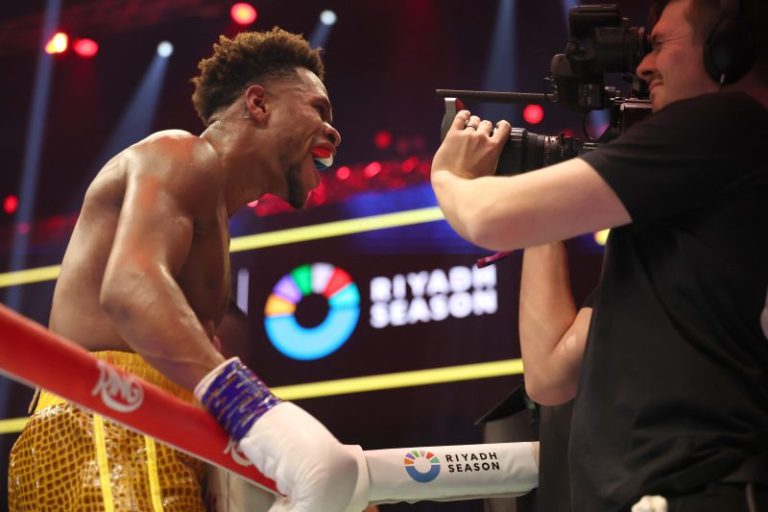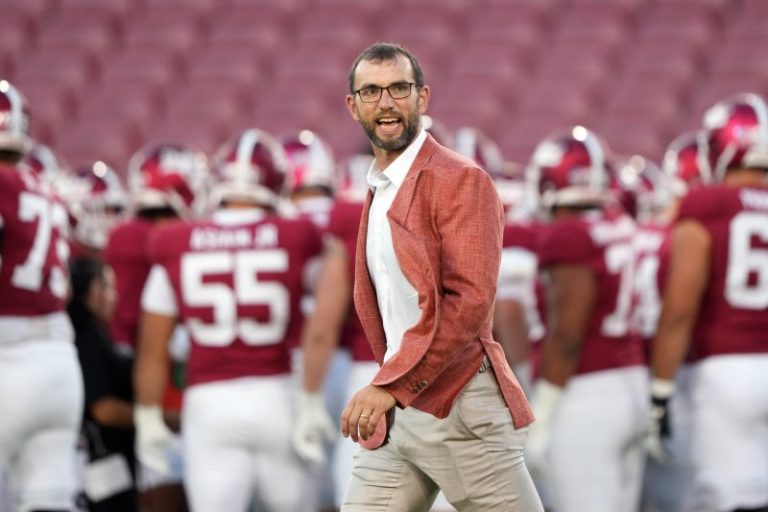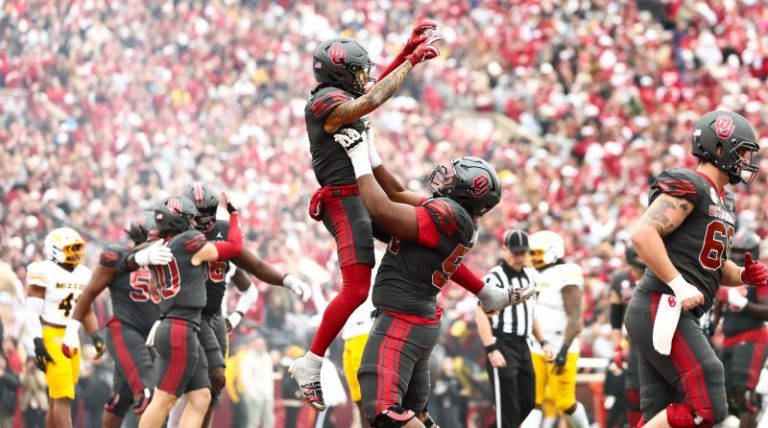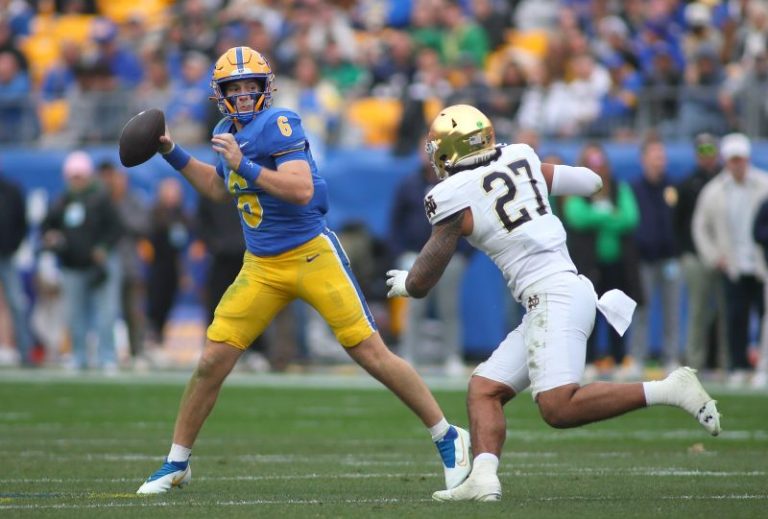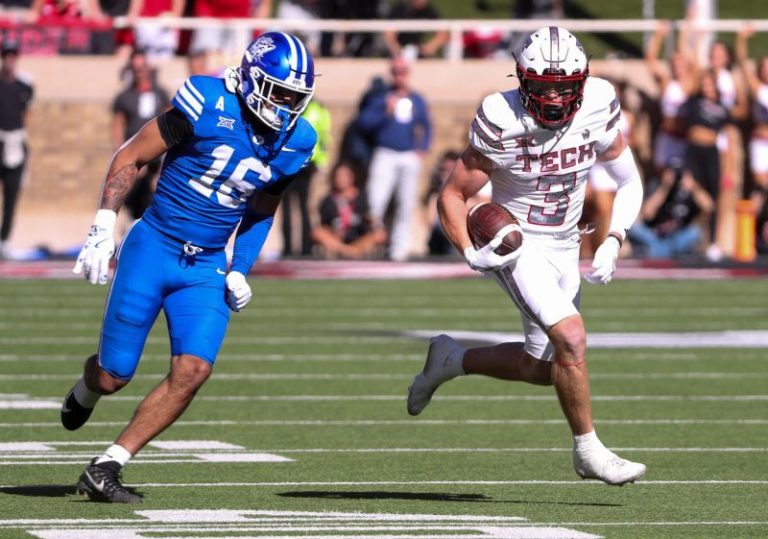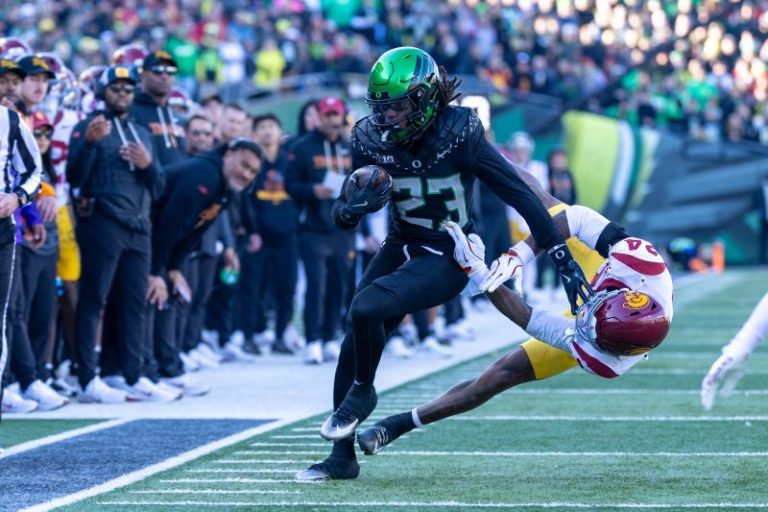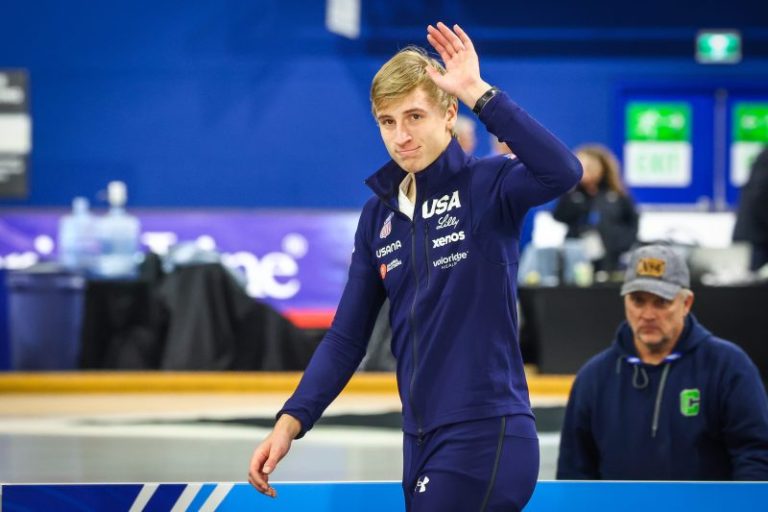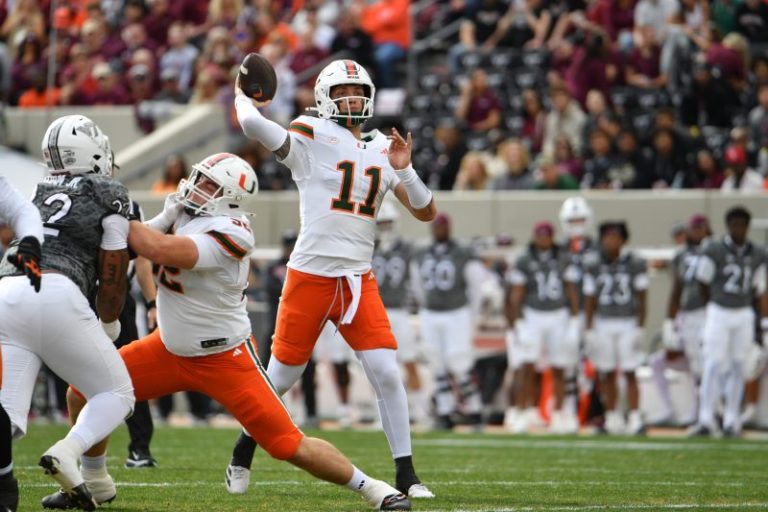David Benavidez waited years for a career-defining fight with Canelo Alvarez. It’s unlikely that matchup now ever will take place, but fortunately for Benavidez he has found another path to potential greatness.
On Saturday, he defended his WBC world light heavyweight title against Anthony Yarde in brutal fashion. He knocked Yarde down twice in the seventh round and was wearing lots of Yarde’s blood before the referee called the fight after that second knockdown.
Benavidez, who stayed undefeated, wasn’t the only one celebrating.
In the co-feature, Devin Haney knocked down Brian Norman Jr. on the way to a victory by unanimous decision. In his debut as a welterweight, Haney won the WBO welterweight title and became a three-division champion.
Benavidez, the 28-year-old from Miami, improved to 31-0.
Yarde, the 34-year-old from Britain, fell to 27-4.
David Benavidez maps out plans
David Benavidez sounded like he was feeling elation and frustration after beating Anthony Yarde by seventh-round TKO.
“I told everybody I was going to steal the show Saturday, and I think I did that,’’ Benavidez said.
But the circumstances weren’t what he hoped. Benavidez, the WBC light heavyweight champ, said he wanted to fight Dmitry Bivol, the unified light heavyweight champ. But he said it’s unclear if that will happen after Bivol indicated he wants to fight Artur Beterbiev a third time and had back surgery in August.
“I don’t want to wait for nobody anymore,’’ Benavidez said. “I waited for Canelo. That fight never happened. Now I’m waiting for Bivol and that fight’s not happened.’’
So, Benavidez announced, he will move up to the 200-pound cruiserweight division and fight Gilberto Ramirez, who holds the WBO and WBA titles. He also said he’d be willing to fight Jai Opetaia, the IBF cruiserweight champion and likely the best in the division.
“That’s what I’m here for, to prove myself,’’ said Benavidez, who indicated he will bounce back and forth from the light heavyweight and cruiserweight divisions in the hunt for titles.
“I want to achieve greatness,’’ he said.
What Devin Haney said after his victory
For Devin Haney, this was no ordinary moment after beating Brian Norman Jr. and winning the WBO welterweight title.
“In 2024, I lost everything,’’ Haney told DAZN after the fight. “Everything came crashing on me. In 2025, I came to get it back. In 2026, I’m coming for everything.’’
Although Haney knocked down Norman in the second round, he was unable to keep the fight from going the distance.
“(Norman) came out exactly how we planned, so I was able to capitalize,’’ Haney said. “But after I hurt him and dropped him, he made an adjustment so we had to adjust to that as well.
“But he’s a true champion. He’s definitely better than I expected. … I thank him for giving me the opportunity to become champion again.’’
Ryan Garcia vs. Devin Haney rematch?
Bill Haney, Devin Haney’s father and manager, indicated a rematch between his son and Ryan Garcia is a possibility.
Especially if Garcia beats Mario Barrios Feb. 21 for the WBC welterweight title. On Saturday, Haney won the WBO welterweight title with a victory over Brian Norman Jr.
“It’s no secret … we have a rivalry with that team that goes back to the amateurs,’’ Bill Haney told reporters. “So we have unfinished business. I will never say he’s not somebody that’s on our radar.’’
During their fight in 2024, Garcia knocked down Haney three times. But Garcia’s victory by majority decision became a no contest after he tested positive for Ostarine, a performance-enhancing drug. He served a one-year suspension.
“But being clean and being a clean fighter, we want to make sure that that’s intact,’’ Haney said.
Ryan Garcia says he bet $50K on Devin Haney to win
Ryan Garcia posted on his X account a betting slip that indicated he wagered $50,000 on Devin Haney to beat Brian Norman Jr. in the WBO welterweight title fight. It appears Garcia is now much richer.
‘Congratulations Devin, great performance,” Garcia wrote in a subsequent post.
If Garcia beats Mario Barrios, that could lead to a rematch with Haney.
David Benavidez vs. Anthony Yarde round-by-round analysis
Here’s how their WBC light heavyweight title fight played out:
Round 1
David Benavidez does not have a career as a bodybuilder. But he still packs a thunderous punch. Anthony Yarde, by contrast, is cut like a world-class athlete. Benavidez throws a big right, but off of Yarde’s massive arm. Benavidez coming forward, lands a jab to the body and doing more work. Yarde throws nothing of consequence. Benavidez 10, Yarde 9
Round 2
Yarde comes out a little more active, then takes a couple of hard shots from Benavidez on the arm. Benavidez remains more active. Yarde scoring with his jab. Benavidez unleashing and, in a corner, Yarde flips him around and moves out of danger. Benavidez fires a combo. Benavidez 20, Yarde 18
Round 3
Yarde comes out peppering Benavidez with jabs. Benavidez unloads heavy punches but nothing connects solidly. Action heightens. Yarde fighting back but not with ferocity. Benavidez lands a signature combo, but Yarde looks no worse for the wear. More punishment from Benavidez. Benavidez 30, Yarde 27
Round 4
Benavidez again comes out the aggressor. Yarde lands a nice counter and then a jab. But Benavidez is punching more and harder, including another signature combo. Benavidez calling for Yarde to punch and then unloads with a flurry as the round ends. Benavidez 40, Yarde 36
Round 5
Yarde pawing with the jab. Zzzzzzzz. Yarde turns it up a bit, but Benavidez is sill marching forward and landing stiff blows, especially when he gets Yarde on the ropes. Yarde almost looks like he’s shadow boxing when he’s not impersonating a heavy bag. Yarde lands a hard right, and Benavidez responds with a flurry. Benavidez 50, Yarde 45
Round 6
Yarde opens the round with a hard right and goes on the attack, smothering Benavidez on the ropes. Benavidez fights off the ropes but not before absorbing punches. Benavidez calling for Yarde’s punches and then unleashes a couple of his own. Benavidez draws blood from Yarde’s nose as Benavidez picks up the pace. It’s all Benavidez, who’s streaked with Yarde’s blood. Benavidez 60, Yarde 54
Round 7
Before round starts, doctor inspects the bloody nose. Fight is on again. Benavidez doing his thing, landing huge punches. This is the Mexican Monster! He drops Yarde into the corner. Yarde’s up but not looking good. Ref takes away a point from Benavidez for hitting Yarde when he was down. Yarde shows a little fight, but Benavidez is about to knock him out. He’s just destroying Yarde and the ref halts the fight! Mercifully. It’s Benavidez by TKO!
Devin Haney def. Brian Norman Jr. by unanimous decision
Devin Haney found a way to end the talk of how a beating against Ryan Garcia damaged his career.
Haney defeated Brian Norman Jr. by unanimous decision, won the WBO welterweight title and became a three-division world champion. He also owned lightweight and super lightweight world titles before the judges on Saturday assured he had a third.
The judges scored it 114-113, 117-110, 116-111 for Haney, who made his debut at welterweight against one of the division’s hardest punchers.
Known more for skill than power, Haney knocked down Norman with a hard right. Then he used his boxing acumen to keep Norman at bay while staying undefeated (33-0) and handing Norman (28-1) his first loss as a pro.
Haney no longer looked haunted by his 2024 fight with Garcia, who knocked down Haney three times on his way to a majority decision victory. The result was changed to no contest after Garcia tested positive for the performance enhancing drug Ostarine.
In his next bout, Haney looked tentative in an unimpressive victory over Jose Ramirez by unanimous decision. But in the ring Saturday against a dangerous fighter, Haney showed poise and power.
Brian Norman Jr. (c) vs. Devin Haney round-by-round analysis
Here’s how their WBO welterweight title bout played out:
Round 1
Brian Norman Jr. fires quick jabs and is the aggressor. Devin Haney looks tentative and ducks on the ropes before the referee separates the fighters. Haney does look muscular in his first fight as a welterweight. But let’s see if he can regain any of his old aggression. Still waiting on Haney’s first punch. Ah, there comes a hard left hook that whiffs. Norman makes contact with a combo. Norman pounds Haney with a left and then goes on the attack. Norman 10, Haney 9
Round 2
Nice exchange of lefts and Haney scores with a left jab. Haney quick to retreat. Haney drops Norman with a right!! Norman definitely is dazed. But he’s back up. Haney on the attack. Norman fighting back. Suddenly Haney’s showing aggression! Norman looks stunned as blood pours out. Haney firing jabs and scores with a hard right. Haney looks terrific. Haney 19, Norman 18.
Round 3
Norman wiping the blood from his nose. But he charges at Haney. No backup from Norman. Haney throws a jab but then comes under assault. Haney responds with jabs. But Norman pounces. Haney 28, Norman 28
Round 4
Norman the aggressor, but Haney sneaks in a shot to the back of the head. Haney scoring with the jab again. But Norman responds with a hook. Haney looks composed. Haney 38, Norman 37
Round 5
Haney looking for his shot rather than punching his way into position. Norman fires the jab. Haney scores with a right. And then lands a jab. Norman rushes in to stay the onslaught. Haney lands another hard right in a measured approach while Norman bulls forward. Norman lunging without any sense of control. Haney 48, Norman 46
Round 6
Norman works Haney into the corner, but Haney exits quick with help from the ref. Norman rushing forward in spurts, and scores with a body shot. Swing and a miss from Norman – evidence of struggling to find the distance. Haney making good use of the jab. Haney 58, Norman 55
Round 7
Haney connects with a hard left. Then tags Norman with a right. And connects with a left. Haney looking to end this here and now? And Norman swinging and whiffing. Another wild punch. Haney in control. Haney 68, Norman 64
Round 8
Haney seems content with Norman remaining the aggressor. Norman lands a couple of shots as Haney grows less active before missing with a jab. Norman turns it into a wrestling match. Haney finds his rhythm again with three jabs, then misses with a hard right. Haney 77, Norman 74
Round 9
Norman comes out working behind the jab. Up go chants of, “Let’s go Devin!’’ Maybe it’s time for Devin to get going again. Norman won’t set any accuracy records, but he’s continuing to punch. And caught Haney with a hard one and now he’s showing aggression again. Haney lands a jab, but Norman is coming with harder shots. Haney 86, Norman 84
Round 10
Fatigue setting in? Not much action. But Haney lands a left that Norman shakes off. More wrestling ensues. The punching resumes, but no great exchanges. Haney 95, Norman 94
Round 11
Haney looks a little tentative. Wonder why he’s not willing to put Norman down again? Maybe trying to preserve a scorecard victory as bumper cars ensue. A lot of colliding. Haney unleashes a right that’s not quite on the mark. But Haney scores with a couple of jabs. Haney ducking punches and showing more discipline. Haney 105, Norman 103
Round 12
More clinching, but punching too. Nothing big lands until Norman connects with a left. Norman swinging hard but he’s tangled up with Haney. Haney wrapping him up rather than punching. He throws a jab and clinches again, trying to run out the clock. Haney 115, Norman 112
Devin Haney-Brian Norman Jr., David Benavidez-Anthony Yarde: Time, PPV, streaming for fight
Devin Haney and David Benavidez have title fights on Saturday, Nov. 22, at Riyadh, Saudi Arabia.
Date: Saturday, Nov. 22
Time: 3 p.m. ET (broadcast start)
Devin Haney-Brian Norman Jr. ringwalks: 8 p.m. ET (estimate)
David Benavidez-Anthony Yarde main event ring walks: 9 p.m. ET (estimate)
Stream: DAZN
Watch Haney and Benavidez fights with DAZN PPV
Jesse ‘Bam’ Rodriguez def. Fernando Martinez by KO
Rodriguez climbed into the ring with a former world champion and mostly made him look like a chump. The unified super flyweight champion, Rodriguez ended the bout with a 10th-round knockout.
But it was what transpired before that underscored Rodriguez’s boxing superiority. With slick footwork and punching precision, he stayed undefeated and continued to outclass Martinez, the former IBF world super flyweight champion.
Martinez did land some punches, and perhaps his best one in the 10th round. And so how did Rodriguez respond? He knocked out Martinez with a left hook.
Rodriguez, a 25-year-old from San Antonio, improved to 23-0. Martinez, a 34-year-old from Argentina, fell to 18-1.
Jesse ‘Bam’ Rodriguez vs. Fernando Martinez round-by-round analysis
Here’s how their super flyweight fight played out:
Round 1
Rodriguez is throwing early, but Martinez responds with rights. Rodriguez throwing jabs while Martinez loads up with heavier punches. Rodriguez just sticks with the jab and Martinez clubs Rodriguez and knocks Rodriguez off balance. Martinez slips to the canvass. No knockdown. Rodriguez finds himself in what looks to be a tough fight. But Rodriguez definitely looks more polished by the end of the round. Rodriguez 10, Martinez 9
Round 2
Martinez shows ample power, but Rodriguez’s footwork and precision is starting to set him apart. Martinez is the bull, Rodriguez the matador. Rodriguez taking shots, but looks the classier fighter and now digging into the body. Rodriguez finding his rhythm. Rodriguez 20, Martinez 18
Round 3
Martinez firing away, and he’s connecting. But Rodriguez is dodging punches and then delivering them. Also important to note that Martinez is significantly bigger. But the thinner Rodriguez shows no concern. Rodriguez digging into Martinez’s body and Martinez appears to be hurt. A calculated round from Rodriguez. Rodriguez 30, Martinez 27
Round 4
Rodriguez takes some shots and is dishing out more. Slick footwork as he dodges some punches and keeps connecting. The muscled Martinez is firing away again. Rodriguez ramping things up. Martinez’s power and energy seem to have faded. Rodriguez has drawn blood. Rodriguez 40, Martinez 36
Round 5
Rodriguez revs up again, and Martinez doesn’t look cooked – yet. Rodriguez targeting the body, and Martinez fires back, just not with a ton of success. Rodriguez takes a couple of nice shots, but retaliates with a combination. Rodriguez 50, Martinez 45
Round 6
Rodriguez on the attack, dissecting. Martinez connects with a flurry and then a right. But Rodriguez steadily works a fatiguing opponent. Martinez keeps rubbing his nose. Broken? Sure looks like more than bad allergies. Rodriguez lands another solid body shot. Rodriguez, putting on a masterclass. Rodriguez 60, Martinez 54
Round 7
Martinez, the brawler, comes out brawling. But Rodriguez withstands the early surge and goes back to dissecting his opponent. Rodriguez on cruise control, but he eats a punch too. Does not deter him. Rodriguez 70, Martinez 63
Round 8
Martinez remarkably still showing energy. Rodriguez withstanding an early surge again, then takes control. Martinez still landing punches, but Rodriguez punishes with more authority whenever he chooses. He has worked his opponent’s body relentlessly. Rodriguez 80, Martinez 72
Round 9
Rodriguez won’t be able to take his eye off the ball, or Martinez. He’s controlling this fight. But Martinez still has formidable power despite the optics – blood pouring down his nose. Rodriguez staggers Martinez before he steadies himself. Martinez lands a hard left, but Rodriguez still comes forward. Rodriguez 90, Martinez 81
Round 10
Martinez swinging, but Rodriguez staying on the move and landing far more punches than he’s taking. Rodriguez gets hit with a left, stunning Rodriguez? Wait. Wow! A left hook drops Martinez! It’s over. Jesse “Bam’’ Rodriguez by KO!
Abdullah Mason def. Sam Noakes by unanimous decision
Slugfest. Bar brawl. Back alley fight.
Call it what you want, but Mason survived the carnage, beating Noakes by unanimous decision and at 21 becoming boxing’s current youngest champion while winning the WBO lightweight title.
Mason (20-0) showed precision and power. A bloodied Noakes (17-1) showed relentlessness and guts. And the spectacle stretched the full 12 rounds.
The judges scored it 117-111, 115-113, 115-113 for Mason, a native of Cleveland, after his battle with Noakes, the Brit.
Abdullah Mason vs. Sam Noakes round-by-round analysis
This fight will be Abdullah Mason vs. Sam Noakes for the vacant WBO lightweight title.
Round 1: Sam Noakes fires the first jabs and Abdullah Mason shows he can elude at least one. Noakes moves forward and pressures Mason with combinations. Then he lands another couple of big punches. Noakes is looking very comfortable. Mason throws a couple of jabs and backs away. Noakes presses in and lands again, only for Mason to fire back. Noakes lands another hard right as the round ends. Noakes 10, Mason 9.
Round 2: Mason snapping punches with more authority now, but Noakes corners him and roughs him up a little behind a combo. Now Mason responds with a couple of punishing lefts. Noakes connects with a right, darts in and knocks back Mason with another right. Noakes regains control at the end of the round. Too late to win the round? Probably so. Noakes 19, Mason 19.
Round 3: Noakes comes out firing, lands a right. Mason fires back with body shots. Mason lands a hard left and looks to capitalize. Noakes trying to fight back but is bleeding from a bad cut near his left eye. Fight stopped so ringside doctor can assess the eye. Bout returns. It resulted from a headbutt. Fighters exchanging big punches, but it’s the sharpshooting Mason who’s landing more punches. Mason 29, Noakes 28.
Round 4: Mason flashing his hand speed. Noakes wrapping up Mason and trying to slow things down. Lots of tangling and wrestling ensue. Too much. Noakes lands an uppercut as part of a combo. Noakes trying to keep things rough. An extended exchange here and Mason digs into the body. Mason 38, Noakes 38.
Round 5: More back-alley brawling commences. And that’s Noakes’ kind of fight. Mason lands, but Noakes keeps the pressure on. Mason has a knot on his forehead, and now he’s feeling pain in his body thanks to shot from Noakes. Mason lands a combo to end the round. Mason 48, Noakes 47.
Round 6: Mason comes out a little more committed to fighting from a distance. Noakes won’t allow it. He just keeps coming forward. Mason drilling Noakes with about five straight shots. Mason’s unleashing that left hand and now connects with the right. Can he start creating some distance here? Noakes might be hurt, but he’s undeterred. Mason shows nice defense. Mason 58, Noakes 56.
Round 7: Noakes comes out aggressive, but Mason appears to be in good position to strike. Does just that with a body shot. Mason following up with body shots, and Noakes retaliates with hard shots to the head. Great exchanges. Duking it out here. Noakes closes with a flourish. Mason 67, Noakes 66.
Round 8: Noakes comes out the aggressor. Eats a left, but keeps the pressure on. A rare lull in the action. Mason digs in two hard body shots. Now Mason landing lefts, only for Noakes to fire back. Mason goes back to the body and Noakes appears to be slowing down. Mason pounds him with a hard left. More punishment from Mason but Noakes responds late. Mason 77, Noakes 75.
Round 9: Mason now bulling forward, like Noakes has done. Giving Noakes a taste of his own medicine. He targets Noakes with the left and finds the mark. But Noakes lands a right and he clearly isn’t done yet. Mason pounding Noakes’ body. Noakes showing impressive toughness. More exchanges ensue. Mason showing more precision. Mason 87, Noakes 84.
Round 10: Mason leans into his jab, but Noakes closes the gap, wraps up Mason and things get rough again. Mason throwing combinations and looks like he has more in the tank, only for Noakes to fight back. What a fight. Mason punishing the body again. Noakes takes the punishment and scores with a right. Mason pounds Noakes with a body shot and Noakes is in trouble. Mason on the attack. Noakes somehow holding on. Mason 97, Noakes 93.
Round 11: Mason drilling Noakes with lefts, but Noakes responds with rights. Somehow Noakes appears to have recovered from the previous round. A slugfest is back underway. Noakes lands a flurry and then digs into the body. Noakes now chasing down Mason and he attacks the body. Mason takes a big shot and connects with his own. Mason 106, Noakes 103.
Round 12: Noakes comes out surging, but Mason unleashes his vicious left. A series of them. Wow, another pinpoint left from Mason. But a bloody Noakes fires back. Back and forth it goes. Just incredible output from the bloody Noakes and blood-free Mason. Madness. The slugging is endless. Both fighters pounding and getting pounded. Mason 115, Noakes 113.
Vito Mielnicki def. Samuel Nmomah by TKO
Mielnicki scored with his versatile left jab throughout the middleweight fight. But that’s not how it ended.
In the ninth round, Mielnicki hit Nmomah with a combination that culminated with a left hook – one that dropped Nmomah to the canvas as the round was coming to an end.
Nmomah made it back to his feet but was wobbling, and the referee halted the fight.
After the fifth round, Mielnicki told his corner he had hurt his right hand. Then he leaned even more on his left jab, but during that final combination he proved to have more firepower left in his right hand.
Mielnicki, a 23-year-old from New Jersey, improved to 21-1.
Nmomah, a 28-year-old from Italy, fell to 21-1.
Vito Mielnicki Jr. def. Samuel Nmomah, middleweight
The main card begins with the first fight being Vito Mielnicki Jr. vs. Samuel Nmomah in a middleweight bout.
Round 1: Vito Mielnicki Jr. and Samuel Nmomah come out throwing jabs. Nmomah just misses with a hard right, and Mielnicki is stalking again. Another big swing and a miss from Nmomah, and credit Mielnicki for some defensive prowess. Mielnicki finishes the round scoring with the jab. Mielnicki 10, Nmomah 9.
Round 2: Mielnicki snaps back Nmomah’s head with a jab. He’s sticking with that punch. And moving Nmomah around. Mielnicki picks up the pressure, now throwing his right, too. An exchange of hooks spices things up, but Mielnicki regains control with another combination and by eluding a left hook from Nmomah. Mielnicki 20, Nmomah 18.
Round 3: They come out and go back to the fundamentals – jabs. Mielnicki remains the aggressor. Another big swing and a miss from Nmomah and Mielnicki capitalizes with Nmomah out of position. Mielnicki applies pressure with a flurry. Mielnicki’s making good use of both hands and Nmomah looks a little puzzled about how to fend him off. Mielnicki 30, Nmomah 27.
Round 4: Again, back to the jabs. Nmomah fires a right but it’s off the mark. Mielnicki goes on the attack and Nmomah is backpedaling and then taking cover. Mielnicki ramps up the pressure. Mnomah fighting back but without much accuracy. Mielnicki closing out the round with his effective jab. Mielnicki 40, Nmomah 36.
Round 5: Mielnicki stays patient, opens with the jabs. Nmomah retaliates. Nmomah lands a left and down goes Mielnicki. But the referee waves it off, and a replay shows Nmomah pulls Mielnicki by the back of the head. Nmomah lands a body shot and suddenly Mielnicki is backing up. Mielnicki moving forward again, but Nmomah looks comfortable before a late right by Mielnicki. Mielnicki 49, Nmomah 46.
Round 6: Mielnicki tells his corner he’s hurt his right hand before coming out for Round 6. Nmomah’s right looks good as he unleashes an overhand right that’s off the mark. Mielnicki leaning on that left jab, but throws the right too. But Nmomah punishes Mielnicki with a body shot. That does not keep Mielnicki from fighting back. Mielnicki 59, Nmomah 55.
Round 7: How much does Mielnicki’s right hurt? He’s certainly leaning hard on the left jab. So far, Nmomah has not capitalized on the wounded right – if he’s aware of it. Mielnicki attacking Nmomah’s body with the jab. Nmamoh lands a hard right hook, but it’s Mielnick’s round again. Mielnicki 69, Nmomah 64.
Round 8: Mielnick’s throws a right early. Maybe the pain has subsided? But still, leaning on the jab. Nmomah scores to the body. But Mielnicki responds with a big right and maintains his role as aggressor, mostly behind his left hand. Mielnicki lands another hard left and follows up with a left hook and he’s drawn blood from Nmomah. The attack is on. Mielnicki 79, Nmomah 73.
Round 9: Mielnicki not surrendering control. Stalking at the outset. Nmomah fights back but without ferocity as Mielnicki fires that jab. Nmomah throws a couple of wide rights as Mielnicki scores with the jab. Mielnicki lands combinations and down goes Nmomah after a brutal left hook. The ref halts the right. It’s Mielnicki by TKO!
Benavidez vs Yarde, Haney vs. Norman Jr. fight results: Prelims
Mohammed Alakel def. Jiaming Li by unanimous decision (6 rounds, super featherweight)
Julio Porras vs. Pius Mpenda, unanimous draw (6 rounds/super middleweight)
Sultan Almohammed def. Umesh Chavan by TKO (1st round/Super featherweight)
Juan Carlos Guerito def. Barker Ssewanyana (unanimous decision)
16-year-old, Juan El Guerito de Tepito, wins pro debut
The nine-fight card opened with a novelty: Juan El Guerito de Tepito, a 16-year-old from Mexico, arrived at the boxing ring wearing a SpongeBob SquarePants outfit for a big day.
He was making his professional debut, and there was nothing cartoonish about it.
Tepito swung hard with both hands and dominated 31-year-old Barker Ssewanyana of Uganda. Tepito pummeled his opponent with body shots and scored with uppercuts in a victory by unanimous decision in the four-round bantamweight bout.
All three judges scored the fight 40-35 in favor of Tepito, who is trained by Jose Benavidez, father of David Benavidez, the reigning WBO light heavyweight champion who will fight Anthony Yarde the main event.
Ssewanyana fell to 1-2-1.
Guerito makes pro debut rocking SpongeBob
David Benavidez vs. Anthony Yarde fight card
Main card
David Benavidez vs Anthony Yarde; Light heavyweight, for the WBC title
Devin Haney vs Brian Norman Jr.; Welterweight, for the WBO title
Sam Noakes vs Abdullah Mason; Lightweight, for the WBO title
Jesse Rodriguez vs Fernando Martinez; Super flyweight, for the WBA, WBC and IBF titles
Vito Mielnicki Jr. vs Samuel Nmomah
Prelims
Mohammed Alakel vs. Jiaming Li
Sultan Almohammed vs. Umesh Chavan
Julio Porras Ruiz vs. Pius Mpenda
Juan Carlos Guerito vs. Barker Ssewanyana
David Benavidez vs Anthony Yarde fight card odds
All odds are for moneyline bets as of Saturday, via BetMGM
David Benavidez (-1000) vs Anthony Yarde (+550); Light heavyweight, for the WBC title
Devin Haney (-118) vs Brian Norman Jr.(-105); Welterweight, for the WBO title
Sam Noakes (+240) vs Abdullah Mason (-350); Lightweight, for the WBO title
Jesse Rodriguez (-1400) vs Fernando Martinez (+650); Super flyweight, for the WBA, WBC and IBF titles
Vito Mielnicki Jr. vs Samuel Nmomah
David Benavidez vs. Anthony Yarde predictions
Sports Illustrated: Teddy Atlas picks Benavidez
Donal Long writes on behalf of Atlas’ comments: ‘Benavidez, if he gets his way with the body work, the pressure, the volume, the burst, if he gets his way, he will wear down Yarde. At the end of the day, I like Benavidez to win.’
Ring Magazine: Tim Bradley picks Benavidez
Manouk Akopyan writes on behalf of Bradley’s comments: ‘It’s going to be a good fight, but it’s going to be one of those fights where Yarde is going to get drained while fighting. He might have a few rounds where he has a little success, but he’s going to get beat on. It’s going to be like an insect getting trapped in a spider web. That’s exactly how it’s going to be. Benavidez is going to put knots on his head. Yarde is a decent boxer, but Benavidez is too long and the wrong style for him.”
DAZN: Chris Walker, senior boxing writer picks Benavidez
Andrew Steel writes: ‘Anthony Yarde has been here before, but can he get it right at the third time of asking? Losses to Sergey Kovalev and Artur Beterbiev at world title level have ruined Yarde’s dreams in the past and he faces another stern test in the shape of David Benavidez. The Arizona man is on the verge of becoming a big star and a win over Yarde on one of the year’s biggest shows could be the platform to push on in 2026. Look for Benavidez to respect Yarde’s power in the early stages before pulling away in the second half for a convincing points win.’
Devin Haney vs. Brian Norman Jr. predictions
Sports Illustrated: Teddy Atlas picks Haney
Donal Long writes on behalf of Atlas’ comments: ‘I’m going to go with Haney. I’m going to say that he’s back mentally, and that he’s okay physically. He’s going to go back to what he always was, a counter-puncher.’
Boxing 24/7: Ryan Garcia picks Haney
Staff writes on behalf of Garcia’s comments: ‘I am confident that Devin Haney wins!! Reason is simply exp and I feel he will figure it out.’
Sports Illustrated: Regis Prograis Haney
Donal Long writes on behalf of Prograis’ comments: ‘Devin is not just a good boxer, he’s a great boxer. He’s getting stronger, he’s getting better. He’s motivated by the hate; he loves it. So, people can say what they want… If I had to bet my money, I would bet money on Devin.’
Devin Haney and David Benavidez main card, ring walk start times
Main card start time: 5:15 p.m. ET
Devin Haney vs Brian Norman Jr. Co-Main event ring walks: 8 p.m. ET (approximate)
David Benavidez vs Anthony Yarde Co-Main event ring walks: 9 p.m. ET (approximate)
David Benavidez vs Anthony Yarde live stream, price
Devin Haney will fight Brian Norman Jr. just before David Benavidez takes on Anthony Yarde on Saturday, Nov. 22, and the event will be DAZN PPV. In the U.S., fans can purchase the event for $59.99.

